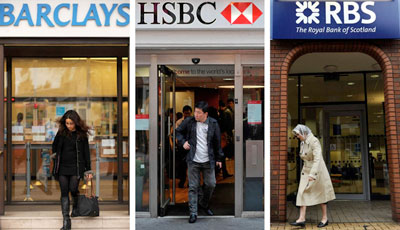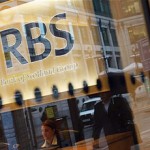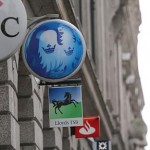RBS,HSBC, Barlcays and StanChart announced their stress test results

The Royal Bank of Scotland Group plc, HSBC Holdings plc, Barclays PLC and Standard Chartered PLC have issued press releases to announce their results in relation with the 2015 Bank of England stress test.
Royal Bank of Scotland Group plc
RBS’s transitional Common Equity Tier 1 (“CET1”) capital ratio under the hypothetical adverse scenario was 5.9%. After the impact of management actions, the ratio was 6.1%, which was above the 4.5% post-stress minimum CET1 capital ratio threshold set by the BoE.
RBS’s Tier 1 leverage ratio under the hypothetical adverse scenario was 2.9%. After the impact of management actions, the ratio was 3.0%, which met the 3.0% post-stress minimum Tier 1 leverage ratio threshold set by the BoE.
Taking into account the capital actions achieved so far in 2015 and those planned in the future, RBS does not need to alter its current capital plan as a result of the stress test, including the requirements relating to its Individual Capital Guidance (“ICG”).
Commenting on the results, Ewen Stevenson, Chief Financial Officer, said:
“We are pleased with the progress we have made relative to the 2014 stress test, but recognise we still have much to do to restore RBS to be a strong and resilient bank for our customers.”
“During 2015 we have continued to strengthen our core capital ratio and improve our leverage position. Following the divestment of Citizens in October 2015, our pro-forma CET1 ratio at 30 September 2015 would have been 16.2% and our leverage ratio 5.6%.”
HSBC Holdings plc
The Bank of England’s results show that, under the hypothetical stress scenario, HSBC’s CET1 ratio would fall to a low point of 7.7 per cent, well above the Bank of England threshold CET1 ratio of 4.5 per cent.
The Bank of England’s stress scenario modelled a pronounced impact on markets in which HSBC operates, including hypothetical significant moderation of growth in China, a severe downturn in Hong Kong and sharp asset price corrections in both. Under the severe scenario, the results demonstrate the Group’s continued capital strength.
The results incorporate management actions that have been accepted by the Bank of England for the purposes of this exercise. Under adverse economic circumstances, we would in practice consider a variety of management actions depending on the particular prevailing circumstances. Our intention, as evidenced by past actions, is to maintain a conservative and prudent stance on capital management.
Barclays PLC and Barclays Bank PLC
Under the BoE‟s assessment of the effects of the modelled adverse stress scenario, Barclays‟ minimum stressed Common Equity Tier 1 (“CET1”) ratio over the period 2015-19 was 7.3% after the impact of strategic management actions.
The minimum stressed CET1 ratio before the impact of strategic management actions of 6.8% exceeded the 4.5% minimum threshold by a significant margin. Given the impact of strategic management actions, conversion of AT1 securities is not triggered in the stress scenario.
Barclays reported a 10.2% PRA Transitional CET1 ratio as at 31 December 2014, which was the starting point for the stress test modelling. This had increased to 11.1% as at 30 September 2015. Barclays continues to target an end state fully loaded CET1 ratio of greater than 12%.
The minimum stressed Tier 1 leverage ratio was calculated at 3.3% after management actions and 3.2% before management actions, both above the 3.0% minimum threshold. Barclays reported a 3.7% Tier 1 leverage ratio as at 31 December 2014, which was the starting point for the stress test modelling. This had increased to 4.2% as at 30 September 2015.
The full year results for 2015 and the Annual Report will be published on 1 March 2016.
Standard Chartered PLC
The Group met both the CET1 Capital ratio and the Tier 1 Leverage Ratio requirements after the impact of strategic management actions.
The results of the stress test showed that the Group had a CET1 Capital ratio of 5.1 per cent. before the impact of strategic management actions, and 5.4 per cent. after the impact of strategic management actions, compared with the threshold CET1 Capital ratio of 4.5 per cent.
The results of the stress test also showed that the Group had a Tier 1 Leverage Ratio of 2.8 per cent. before the impact of strategic management actions, and 3.0 per cent. after the impact of strategic management actions, compared with the 3 per cent. minimum Tier 1 Leverage Ratio requirement.
Standard Chartered believes that the results demonstrate the Group’s resilience to a marked slowdown across the key markets in which it operates.
The PRA judged that in the hypothetical stress scenario the Group’s Tier 1 Capital Ratio after strategic management actions reduced to 5.9 per cent. which was below the Tier 1 minimum capital requirement of 6 per cent. This assessment did not include the AT1 capital issued by the Group in April 2015.
A number of actions taken since 31 December 2014 have strengthened the Group’s capital and leverage
position:
• The Group reported an increase in its CET1 Capital ratio from 10.7 per cent. at the start of 2015 to 11.5 per cent. as at 30 June 20151
• The Group issued US$2 billion of AT1 securities in April 2015 and reported an increase in its Tier 1 Leverage Ratio from 4.5 per cent. at the start of 2015 to 5.0 per cent. as at 30 June 20152
• The Group announced a fully underwritten 2 for 7 rights issue in November expected to raise GB£3.3 billion (net of expenses), or approximately US$5.1 billion3
In addition, the Rights Issue (as at 30 June 2015) would have on a pro forma basis increased the Group’s CET1 Capital ratio to approximately 13.1 per cent., Tier 1 Leverage Ratio to approximately 5.6 per cent. and Tier 1 Capital Ratio to approximately 14.5 per cent.
The Group is operating with capital levels above current minimum regulatory requirements and has a number of additional levers at its disposal to further manage capital.
Group Chief Executive, Bill Winters commented: ‘We are pleased to have met the PRA stress test thresholds through a significant and prolonged stress scenario. The results of the test demonstrate our resilience to a marked slowdown across the key markets in which we operate. The test was conducted on our balance sheet as at the end of 2014. Since then we have made further significant progress in strengthening our capital position. We are operating at capital levels above current minimum regulatory requirements and have a number of additional levers at our disposal to further manage capital.’
Source: RBS / HSBC / Barclays / Standard Chartered




























